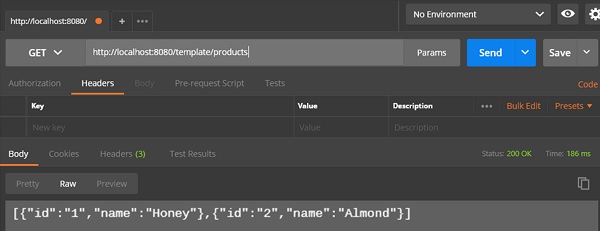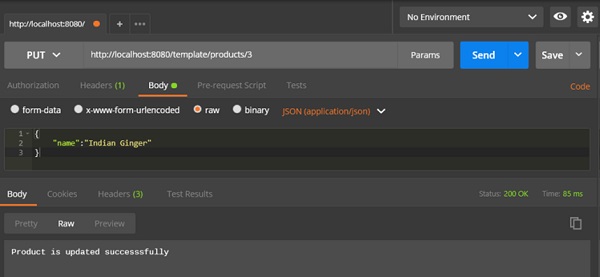Spring Boot Rest模板
Rest模板用於創建使用RESTful Web服務的應用程序。使用exchange()方法爲所有HTTP方法使用Web服務。 下面給出的代碼顯示瞭如何創建Rest模板Bean以自動連接Rest模板對象。
package com.yiibai.demo;
import org.springframework.boot.SpringApplication;
import org.springframework.boot.autoconfigure.SpringBootApplication;
import org.springframework.context.annotation.Bean;
import org.springframework.web.client.RestTemplate;
@SpringBootApplication
public class DemoApplication {
public static void main(String[] args) {
SpringApplication.run(DemoApplication.class, args);
}
@Bean
public RestTemplate getRestTemplate() {
return new RestTemplate();
}
}GET
通過使用RestTemplate類的exchange()方法來使用GET API,
假設此URL => http://localhost:8080/products返回以下JSON,將使用以下代碼使用Rest Template來使用此API響應 -
[
{
"id": "1",
"name": "Honey"
},
{
"id": "2",
"name": "Almond"
}
]必須遵循給定的點來使用API -
- 自動裝配Rest模板對象。
- 使用HttpHeaders設置請求標頭。
- 使用HttpEntity包裝請求對象。
- 爲
Exchange()方法提供URL,HttpMethod和Return類型。
@RestController
public class ConsumeWebService {
@Autowired
RestTemplate restTemplate;
@RequestMapping(value = "/template/products")
public String getProductList() {
HttpHeaders headers = new HttpHeaders();
headers.setAccept(Arrays.asList(MediaType.APPLICATION_JSON));
HttpEntity <String> entity = new HttpEntity<String>(headers);
return restTemplate.exchange("
http://localhost:8080/products", HttpMethod.GET, entity, String.class).getBody();
}
}POST
通過使用RestTemplate的exchange()方法來使用POST API
假設此URL => http://localhost:8080/products返回如下所示的響應,使用Rest模板測試此API響應。
下面給出的代碼是請求正文 -
{
"id":"3",
"name":"Ginger"
}下面給出的代碼是響應內容 -
Product is created successfully需要遵循以下給出的要點來使用API -
- 自動裝配Rest模板對象。
- 使用HttpHeaders設置請求標頭。
- 使用HttpEntity包裝請求對象。 在這裏將
Product對象包裝起來以將其發送到請求主體。
爲exchange()方法提供URL,HttpMethod和Return類型。
@RestController
public class ConsumeWebService {
@Autowired
RestTemplate restTemplate;
@RequestMapping(value = "/template/products", method = RequestMethod.POST)
public String createProducts(@RequestBody Product product) {
HttpHeaders headers = new HttpHeaders();
headers.setAccept(Arrays.asList(MediaType.APPLICATION_JSON));
HttpEntity<Product> entity = new HttpEntity<Product>(product,headers);
return restTemplate.exchange(
"http://localhost:8080/products", HttpMethod.POST, entity, String.class).getBody();
}
}PUT
通過使用RestTemplate的exchange()方法來使用PUT API。
假設此URL=> http://localhost:8080/products/3返回以下響應,使用RestTemplate來響應此API。
下面給出的代碼是請求主體 -
{
"name":"Huawei"
}下面給出的代碼是響應結果 -
Product is updated successfully必須遵循以下給出的要點來使用API -
- 自動裝配Rest模板對象。
- 使用HttpHeaders設置請求標頭。
- 使用HttpEntity包裝請求對象。 在這裏將Product對象包裝起來以將其發送到請求主體。
exchange()方法提供URL,HttpMethod和Return類型。
@RestController
public class ConsumeWebService {
@Autowired
RestTemplate restTemplate;
@RequestMapping(value = "/template/products/{id}", method = RequestMethod.PUT)
public String updateProduct(@PathVariable("id") String id, @RequestBody Product product) {
HttpHeaders headers = new HttpHeaders();
headers.setAccept(Arrays.asList(MediaType.APPLICATION_JSON));
HttpEntity<Product> entity = new HttpEntity<Product>(product,headers);
return restTemplate.exchange(
"http://localhost:8080/products/"+id, HttpMethod.PUT, entity, String.class).getBody();
}
}DELETE
通過使用RestTemplate的 exchange()方法來使用DELETE API
假設此URL => http://localhost:8080/products/3返回下面給出的響應,將使用RestTemplate來使用此API響應。
下面顯示的這行代碼是響應正文 -
Product is deleted successfully必須按照下面顯示的點來使用API -
- 自動裝配Rest模板對象。
- 使用HttpHeaders設置請求標頭。
- 使用HttpEntity包裝請求對象。
爲exchange()方法提供URL,HttpMethod和Return類型。
@RestController
public class ConsumeWebService {
@Autowired
RestTemplate restTemplate;
@RequestMapping(value = "/template/products/{id}", method = RequestMethod.DELETE)
public String deleteProduct(@PathVariable("id") String id) {
HttpHeaders headers = new HttpHeaders();
headers.setAccept(Arrays.asList(MediaType.APPLICATION_JSON));
HttpEntity<Product> entity = new HttpEntity<Product>(headers);
return restTemplate.exchange(
"http://localhost:8080/products/"+id, HttpMethod.DELETE, entity, String.class).getBody();
}
}完整的Rest Template控制器類文件如下 -
package com.yiibai.demo.controller;
import java.util.Arrays;
import org.springframework.beans.factory.annotation.Autowired;
import org.springframework.http.HttpEntity;
import org.springframework.http.HttpHeaders;
import org.springframework.http.HttpMethod;
import org.springframework.http.MediaType;
import org.springframework.web.bind.annotation.PathVariable;
import org.springframework.web.bind.annotation.RequestBody;
import org.springframework.web.bind.annotation.RequestMapping;
import org.springframework.web.bind.annotation.RequestMethod;
import org.springframework.web.bind.annotation.RestController;
import org.springframework.web.client.RestTemplate;
import com.yiibai.demo.model.Product;
@RestController
public class ConsumeWebService {
@Autowired
RestTemplate restTemplate;
@RequestMapping(value = "/template/products")
public String getProductList() {
HttpHeaders headers = new HttpHeaders();
headers.setAccept(Arrays.asList(MediaType.APPLICATION_JSON));
HttpEntity<String> entity = new HttpEntity<String>(headers);
return restTemplate.exchange(
"http://localhost:8080/products", HttpMethod.GET, entity, String.class).getBody();
}
@RequestMapping(value = "/template/products", method = RequestMethod.POST)
public String createProducts(@RequestBody Product product) {
HttpHeaders headers = new HttpHeaders();
headers.setAccept(Arrays.asList(MediaType.APPLICATION_JSON));
HttpEntity<Product> entity = new HttpEntity<Product>(product,headers);
return restTemplate.exchange(
"http://localhost:8080/products", HttpMethod.POST, entity, String.class).getBody();
}
@RequestMapping(value = "/template/products/{id}", method = RequestMethod.PUT)
public String updateProduct(@PathVariable("id") String id, @RequestBody Product product) {
HttpHeaders headers = new HttpHeaders();
headers.setAccept(Arrays.asList(MediaType.APPLICATION_JSON));
HttpEntity<Product> entity = new HttpEntity<Product>(product,headers);
return restTemplate.exchange(
"http://localhost:8080/products/"+id, HttpMethod.PUT, entity, String.class).getBody();
}
@RequestMapping(value = "/template/products/{id}", method = RequestMethod.DELETE)
public String deleteProduct(@PathVariable("id") String id) {
HttpHeaders headers = new HttpHeaders();
headers.setAccept(Arrays.asList(MediaType.APPLICATION_JSON));
HttpEntity<Product> entity = new HttpEntity<Product>(headers);
return restTemplate.exchange(
"http://localhost:8080/products/"+id, HttpMethod.DELETE, entity, String.class).getBody();
}
}Spring Boot應用程序類 - DemoApplication.java 的代碼如下 -
package com.yiibai.demo;
import org.springframework.boot.SpringApplication;
import org.springframework.boot.autoconfigure.SpringBootApplication;
@SpringBootApplication
public class DemoApplication {
public static void main(String[] args) {
SpringApplication.run(DemoApplication.class, args);
}
}Maven構建文件- pom.xml 的代碼如下 -
<?xml version = "1.0" encoding = "UTF-8"?>
<project xmlns = "http://maven.apache.org/POM/4.0.0"
xmlns:xsi = "http://www.w3.org/2001/XMLSchema-instance"
xsi:schemaLocation = "http://maven.apache.org/POM/4.0.0
http://maven.apache.org/xsd/maven-4.0.0.xsd">
<modelVersion>4.0.0</modelVersion>
<groupId>com.yiibai</groupId>
<artifactId>demo</artifactId>
<version>0.0.1-SNAPSHOT</version>
<packaging>jar</packaging>
<name>demo</name>
<description>Demo project for Spring Boot</description>
<parent>
<groupId>org.springframework.boot</groupId>
<artifactId>spring-boot-starter-parent</artifactId>
<version>1.5.8.RELEASE</version>
<relativePath/>
</parent>
<properties>
<project.build.sourceEncoding>UTF-8</project.build.sourceEncoding>
<project.reporting.outputEncoding>UTF-8</project.reporting.outputEncoding>
<java.version>1.8</java.version>
</properties>
<dependencies>
<dependency>
<groupId>org.springframework.boot</groupId>
<artifactId>spring-boot-starter-web</artifactId>
</dependency>
<dependency>
<groupId>org.springframework.boot</groupId>
<artifactId>spring-boot-starter-test</artifactId>
<scope>test</scope>
</dependency>
</dependencies>
<build>
<plugins>
<plugin>
<groupId>org.springframework.boot</groupId>
<artifactId>spring-boot-maven-plugin</artifactId>
</plugin>
</plugins>
</build>
</project>Gradle構建文件 - build.gradle 的代碼如下 -
buildscript {
ext {
springBootVersion = '1.5.8.RELEASE'
}
repositories {
mavenCentral()
}
dependencies {
classpath("org.springframework.boot:spring-boot-gradle-plugin:${springBootVersion}")
}
}
apply plugin: 'java'
apply plugin: 'eclipse'
apply plugin: 'org.springframework.boot'
group = 'com.yiibai'
version = '0.0.1-SNAPSHOT'
sourceCompatibility = 1.8
repositories {
mavenCentral()
}
dependencies {
compile('org.springframework.boot:spring-boot-starter-web')
testCompile('org.springframework.boot:spring-boot-starter-test')
}創建可執行的JAR文件,並使用以下Maven或Gradle命令運行Spring Boot應用程序:
對於Maven,使用下面給出的命令 -
mvn clean install在「BUILD SUCCESS」之後,可以在target目錄下找到JAR文件。
對於Gradle,使用下面顯示的命令 -
gradle clean build在「BUILD SUCCESSFUL」之後,可以在build/libs 目錄下找到JAR文件。
現在,使用以下命令運行JAR文件 -
java –jar <JARFILE>現在,應用程序已在Tomcat端口8080上啓動。
現在點擊POSTMAN 應用程序中的以下URL,可以看到輸出。
通過Rest模板獲取產品 - http://localhost:8080/template/products

創建產品POST - http://localhost:8080/template/products

更新產品PUT - http://localhost:8080/template/products/3

刪除產品 DELETE - http://localhost:8080/template/products/3
